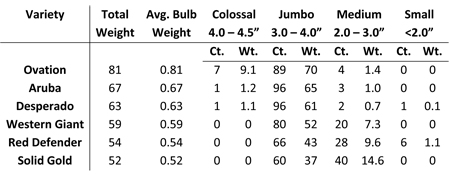It’s time to start sweet onion transplants
For successful Michigan sweet onion production, transplants must be started in the greenhouse in late February or early March
The Michigan onion industry is built primarily on a long-storing, pungent cooking onion with levels of pyruvic acid above 10 mg. However, the current growth area in United States onion consumption is in sweet onions (those having less than 10 mg). Due to lower pyruvic acid levels sweet onions do not store well and must be sourced from several locations during the growing season.
Sweet onions can be grown in Michigan if correct cultivars are chosen and seed started at the right time. Seed must be started in the greenhouse late February or early March for field transplanting in late April or early May. To get suitable transplant size and quality now is the time to start. A number of cultivars have done well under Michigan conditions and are listed in Table 1.
Table 1. Evaluation of 100 bulbs from six sweet onion cultivars grown as transplants at the Southwest Michigan Research and Extension Center in Benton Harbor, Michigan in 2010. Weights (Wt.) are in pounds. Ct. = bulb count in that diameter size range.

Onions are day-length sensitive so it is critical that proper cultivars are selected. Cultivars grown in Michigan must be long-day types. These will bulb as a result of days getting longer in May and June. Since final bulb size is directly related to plant size prior to bulbing, it is important to treat plants well with proper fertilizer and irrigation prior to them receiving the bulbing signal. Some intermediates-day types will do well in Michigan but short-day responsive types should not be grown.
Research on sweet onions is ongoing at the Southwest Michigan Research and Extension Center in Benton Harbor. Past efforts have been at identifying cultivars adaptable to Michigan conditions. Current efforts are aimed at developing a means of getting suitable size from direct seeded plantings. Further information can be obtained at http://agbioresearch.msu.edu/swmrec/publications.html#ar.
For more information contact Dr. Ron Goldy, Michigan State University Extension Vegetable Educator at 269-944-1477, ext 207, or goldy@anr.msu.edu.



 Print
Print Email
Email




